This is a journal entry from our first days in Indonesia.
We are in the mountains of West Timor in a town called Soe (SO-way). We can thank the family of our Indonesian friend Vonce, because they thought that a weekend in the mountains would be a welcome break from the steamy port town of Kupang, and they were kind enough to invite us along.
When we finished breakfast at our Kupang hotel this morning, we were expecting that Vonce’s brother would be there at 10 to pick us up. With only a two-hour road trip to Soe, we’d have the entire afternoon to kick back and relax. We could do absolutely nothing until dinner.
But no.
Johny showed up at our hotel half an hour late, with no apology. Okay, maybe the whole jam karet thing is a major part of Indonesian culture, but a heads-up would have been nice. I mean, we could have gone to the pool for an hour or something, instead of just sitting around the room waiting for him to show usp.
This lackadaisical attitude toward time is going to take some serious effort to get used to. At least, if we plan to enjoy living in bali.
Little did we know that we’d have a lot of other culture shocks before we would finally arrive at our hotel. Living in Bali as an expat is not for the faint hearted!
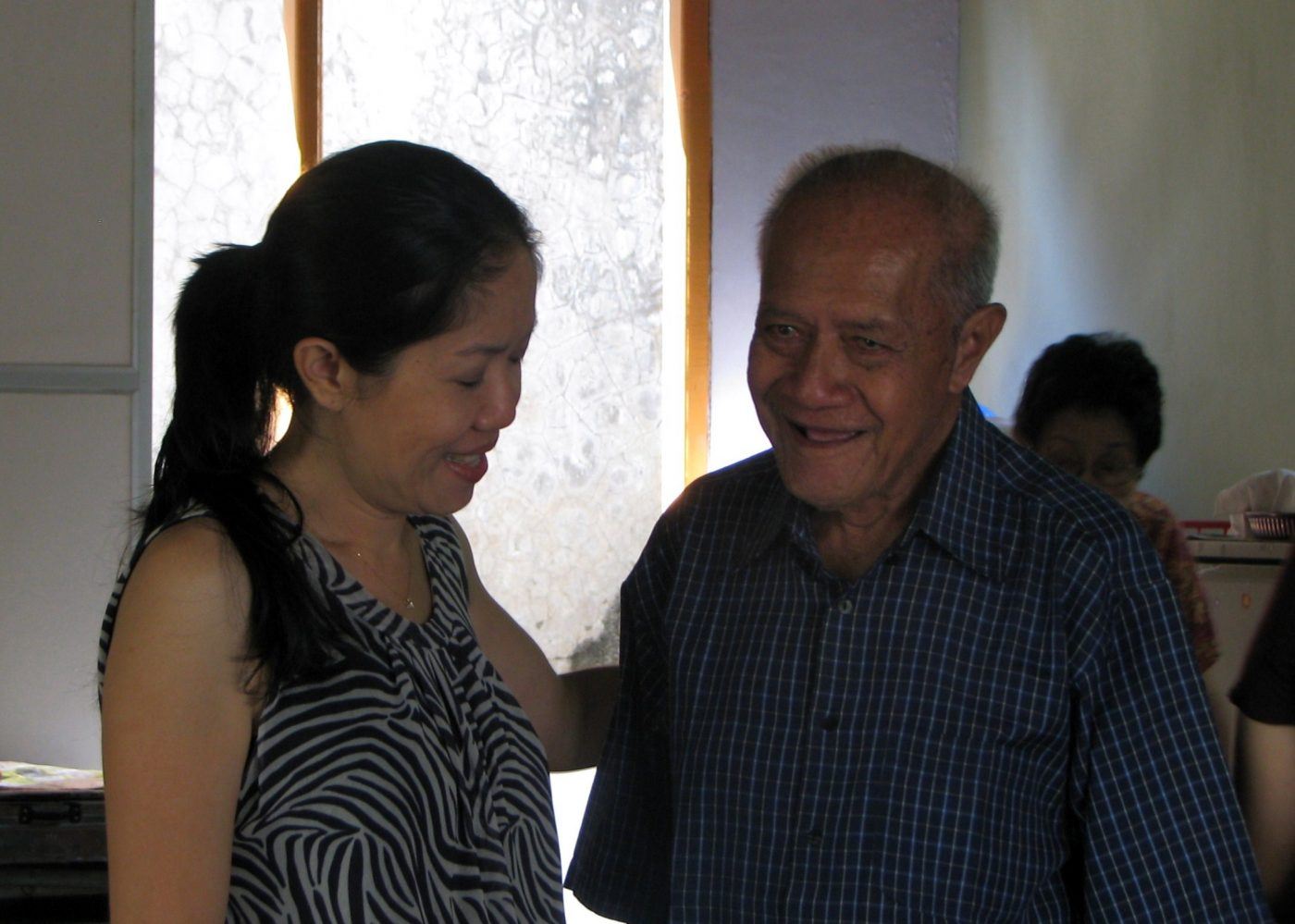
Rather than leave town, Johny took us back to his place. He couldn’t head out until his wife Fonny had finished packing. We all got out of the car to say hello to Mama and Papa while we waited. Their elderly parents are adorable, but they preferred to stay behind.
Almost an hour later, we heaved a collective sigh of relief. Soe, here we come!
Road trip must-have: Snacks!
Johny, Fonny and her sister Vonce sat in the front seat chattering away in Indonesian as the car headed out of town. Johny soon stopped in front of a shop called “Paris Bakery.” Apparently the women wanted some Kupang-style baked snacks before we went any further. The three of them climbed out of the front seat and went inside while the rest of us sat in the car. When they came back they handed out little cellophane-wrapped packets to everyone.
Okay, Dan and I knew they weren’t Little Debbie’s snack cakes, but they looked suspiciously similar. At first glance I hoped it might be something like a chocolate brownie … and then they told us it was a Kupang specialty called kue wajik.
By this time we had learned a few important lessons:
- kue means cake
- brown never means chocolate
- even the sweetest of Indonesian snacks pales in comparison to the sugar in American treats
- Indonesian cakes are nothing like the ones we used to eat at parties back in the US. Nothing at all.
The cakes we had grown up on are incredibly sweet, flour-butter-and-egg creations, covered in mounds of sugary icing, that come on a plate with ice cream, give everyone a massive sugar rush that lasts for hours and make kids climb on the walls.
These little cellophane-wrapped packets, however, were small enough to fit into the palm of my hand. Moist and slightly sticky, the taste was only slightly sweet and a tiny bit coconutty. I also thought it was a little oily, but when I got the kue wajik recipe from Mama, I was surprised to find that no oil is used.
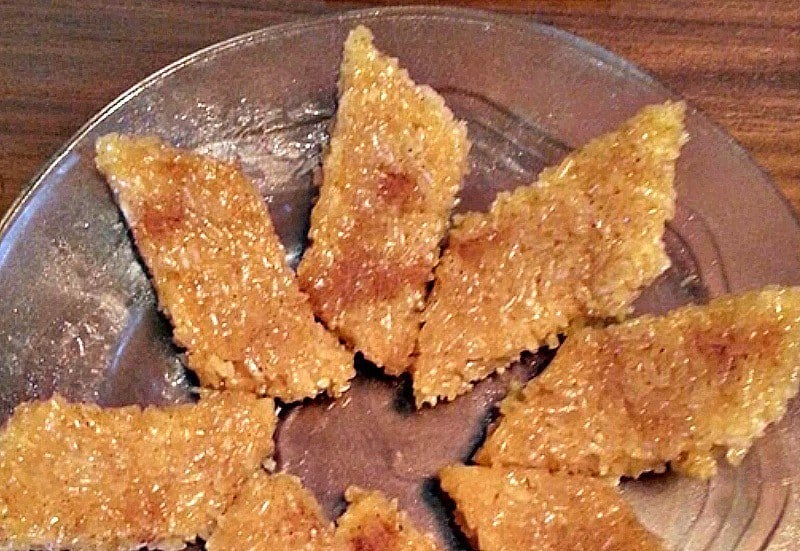
Time for more snacks
After driving for an hour or so, the women again began to chatter excitedly in the front seat and Johny pulled the car over to the side of the road. Sure enough, they were hungry and wanted to buy some fried snack cakes from another roadside vendor.
Then, further along the road, Johny stopped to buy some fruit. Dan whispered, “That’s why Indonesians take so long to get anywhere, they’re always stopping to eat.”
Now that I think of it, maybe that’s how jam karet really began. 😉
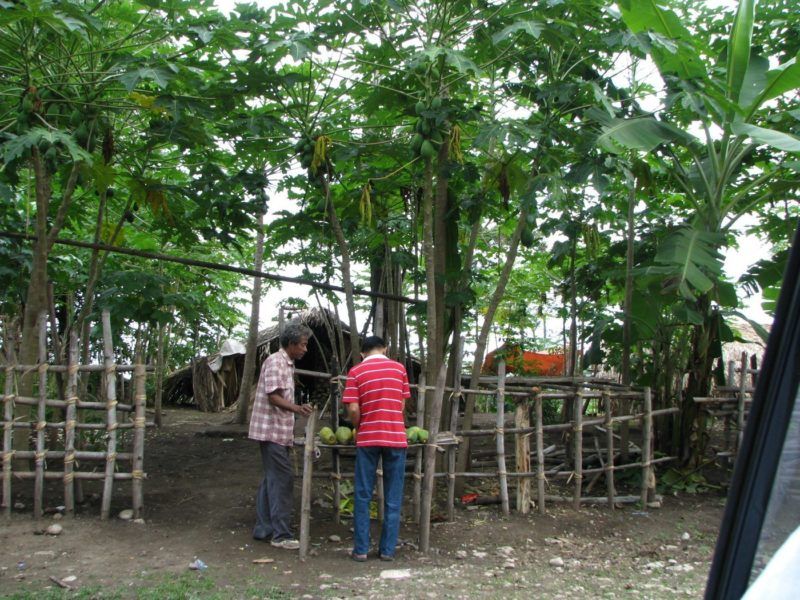
Noelmina River
Finally on the road again, Dan and I got absorbed in watching the passing scenery and lost all sense of time … until we noticed we had passed through a town called Takari and were detouring onto a dirt road.
Are we there, yet?
Nope. The car suddenly headed down a steep incline, over a wide bed of dirt and rocks, and stopped at the edge a shallow but rapidly-moving river. Johny parked by the water so we could stretch our legs and take a few pictures.

I couldn’t understand what was particularly remarkable about this expanse of rocks until he explained that during the rainy season, the mega-wide area we were standing on can suddenly become inundated by a raging torrent of water. Even when no rain clouds are in sight, rainwater can flow down from the mountains with no warning.
Johny told us he was glad it’s dry season. Apparently one of his maids was from the area and had lost her parents here when they were caught in an unexpected flood with no hope of escape.

More Indonesian habits to get used to
While everyone was standing around, a man walked over to watch us. He just squatted down … and stared. Indonesian mothers obviously don’t chide their children not to stare because they don’t consider it at all impolite. Many Indonesians seem to spend their idle time outdoors watching everything. That seems to be their entertainment, more than TV. Now that I think of it, I haven’t yet noticed anyone sitting on his porch steps, or reading a book.
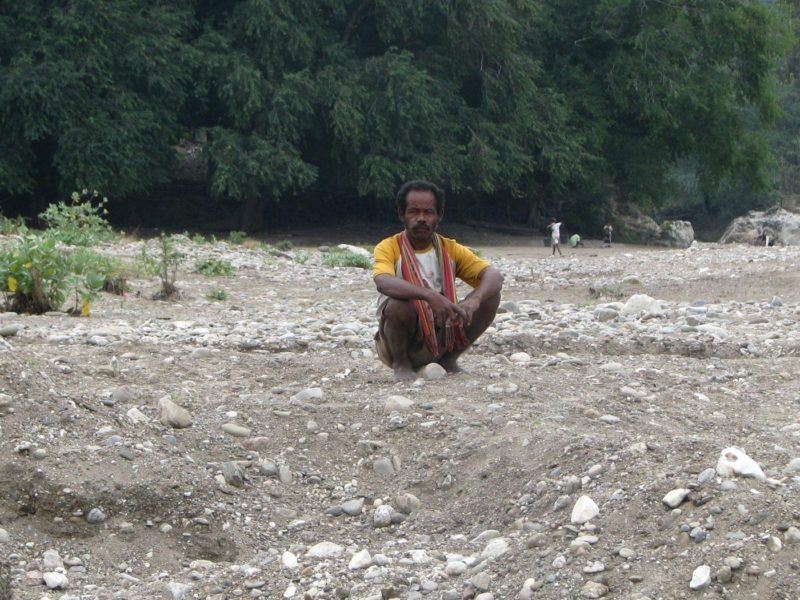
Maybe the staring could be ignored, but certainly not the squatting. Just the thought of it makes my knees hurt! Indonesians commonly squat for long periods of time, but then it’s no big deal for them because they’re used to doing it. They even squat when they go to the bathroom. Man, their legs must be strong!
Raw culture
ⓘ WARNING: If blood makes you squeamish, scroll down quickly and don’t look at the next picture.
While I was still marveling at our observer’s stamina, a van arrived and parked in the river nearby. The driver lifted the tailgate and we heard a pig start squealing. We watched them hold its head and swiftly slit its throat. Its eyes rolled back in its head before blood began to flow over the bumper and drip into the water below.
This wasn’t a regular slaughter, Johny explained. We were watching our first animal sacrifice. It’s not uncommon to see them throw the pig’s carcass into the water as part of their offering. When the squealing stopped, I watched and waited to see if the poor beast would be hauled out and disposed of in the river but they obviously had a different plan. Instead they washed off the bumper, closed the back, and drove away.
I guess the pig was destined to be someone’s dinner. Gross. Well, if nothing else at least they were environmentally conscious.

Kolbano Beach
By the time it hit 2 pm, our stomachs were rumbling. Johny decided to stop for lunch at a beach along the Timor Sea. There was a park adjacent, which was chock full of locals. Of course, they all looked at our car as we pulled in.
More staring.
Yes, as soon as we got out of the car, a group of men sat down nearby to watch us eat. To watch us eat. How bizarre. It made me feel rather like a celebrity. I guess bules (foreigners) don’t come to this beach often.
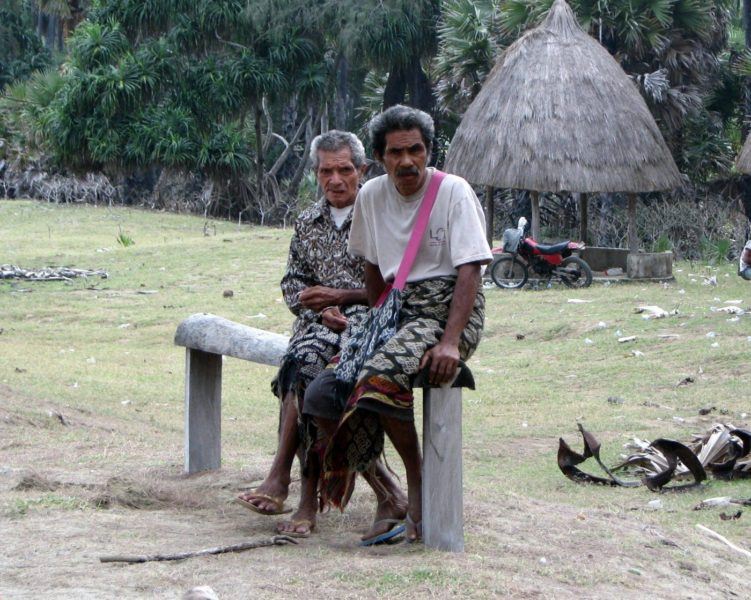
I finally figured out why Fonny had taken so long to get ready for our trip. She brought out an amazing spread of Indonesian deliciousness: hot rice, chicken, hot and cold salads, and of course Coca-Cola. Coke is a classic family favorite in Indonesia. That doesn’t have to be ice cold, but Indonesians have huge thermoses to keep their rice warm on trips.
As we ate, we watched teenage boys playing “shirts and skins” soccer on the beach. As Dan said, some things are universal. Meanwhile, the younger boys gathered under a tree to watch us strangers.

Dan and I walked down to the waves to wash our hands after lunch. The sand was powdery-soft and the water warm. We looked to the horizon, thinking, Australia is only 250 miles away. In that direction.
While Fonny put the food away, the rest of us headed off for a beach walk. Every time we turned around. we’d see the local children following us. I thought it was cute how they’d run and hide as soon as we turned our cameras on them.
They finally warmed up to the little guy who was with us.

By the end of our visit though, they sure didn’t have a problem trusting us enough to accept what was left of our liter of Coke!
Which gave Dan and me a chance to get some truly priceless photos of those children on Kolbano Beach.

Up the mountain to Soe
Back on the road again, we continued on our journey. The nearby town of Kolbano must get most of its income from growing rice because we passed a lot of houses with rice spread out on tarps in the front yard. Some homes had gardens, too, and verdant yards that were little more than flooded rice paddies with a walkway to the front door.
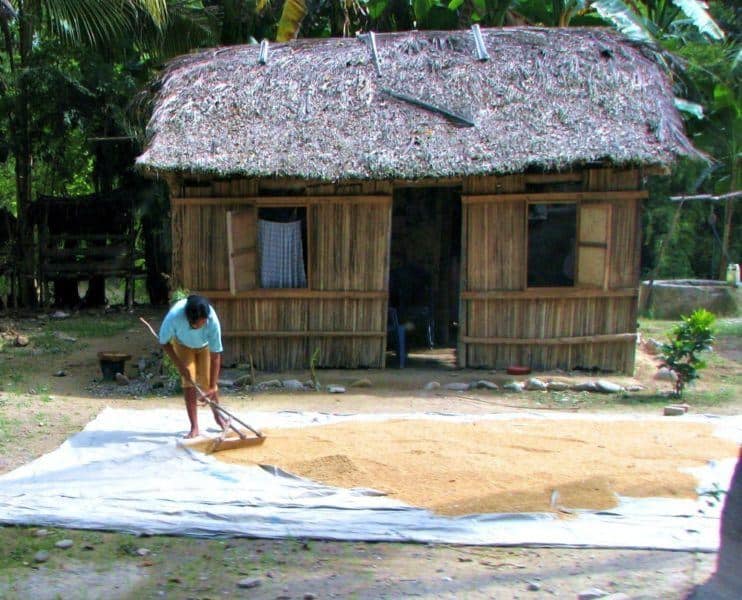
For me, the most enjoyable part was driving through the villages that dotted the road along the way. Random chickens occasionally ran across the road (which almost begged the eternal question, why?) — and we both found the roadside markets intriguing.
Speaking of fascinating, we had to stop at one of Johny’s friend’s homes for a potty break. Here was a great opportunity to see how another culture lives as we walked through to the back yard, where the toilet is. (Say what you want about Asian squat toilets, they’re much better than outhouses.) Then, on the way back, I took a peek into the kitchen and got a quick photo of it. Notice that there’s no sink and no stove, just shelves and tables.
ⓘ TIP: If you’re not used to mountain roads, take Bonine or Dramamine before you get in the car. It’s easy to get motion sick, as some of us discovered the hard way. I’m not naming names, but some drivers take those mountain curves faster than they should.
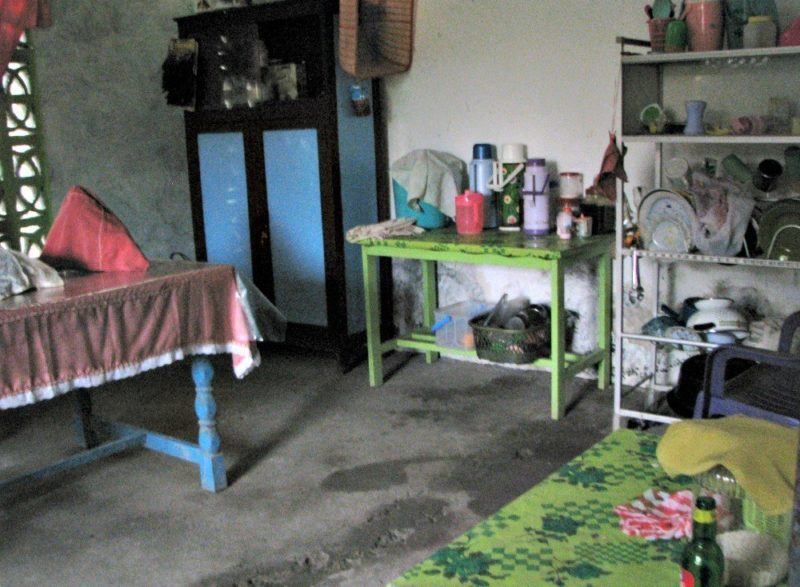
Hotel Gajah Mada
We didn’t arrive at the hotel until after dark. We were offered our choice of a “deluxe room” for 400,000 rupiahs a night (about $44), or a “standard room” for 250,000 a night (about $27). All of the available rooms were on the 3rd floor; the stairs were roughed in and the balcony handrails weren’t installed, but the rooms were ready for guests and they were happy to rent them to us. Try getting away with that in America.
The standard rooms were basic: a queen or two twin beds, a TV on a desk and a sink, plus an en suite bathroom. The deluxe one was similarly furnished but it also included a massive, waste-of-space bathroom with a tub on an elevated platform. Seriously, it was as big as the master bedroom we had back home in the States! Well, that’s what was available, but the others took the remaining queen rooms, so we accepted the standard twin room and pushed the beds together.
In the morning a man stopped by while we were eating breakfast, and he was carrying huge bottles of honey on his shoulders. Everyone took it in stride, because door-to-door vendors are a common sight at hotels. Yep, that’s another thing that would not happen in America!
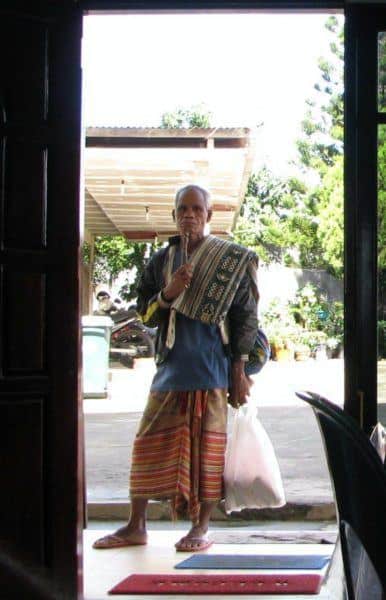
Cost of a dinner in Soe
Dinner for the 8 of us at a local Soe restaurant came to the grand total of about $17. For that we got two big bowls of white rice, 10 skewers each of beef and chicken satay (grilled meat skewers), a bowl of sayur (a delicious swiss chard-like green vegetable), fried chicken, fried shrimp, two other plates of vegetables-and-meat in sauce that I can’t remember, plus 8 drinks.
And there you have it: A two-hour trip that took all day. Maybe jam karet should mean “just enjoy the ride and stop focusing on getting to the destination.“
Jam karet. Welcome to Indonesia.

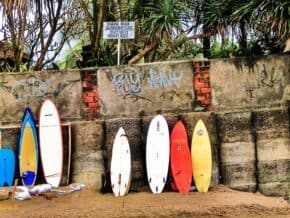
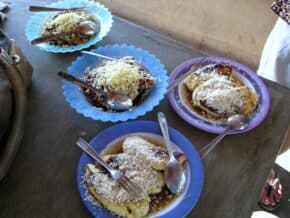
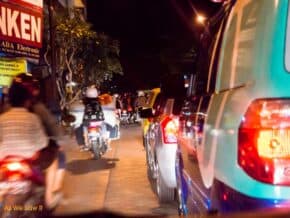
I am from the states and met (and married) a Beautiful girl from Benlutu (10 KM from SOE). It’s a totally different culture but I Love It! If you are white – you are rich! People there are good to you – but watch your money. I found if you have a camera – you make instant friends – especially the children. They always want their picture taken with you! People are so poor – I have seen an old woman picking up rice that was spilled on the street
If you ever go back to SOE – let me know and I will be glad to give you the grand tour!!! [email protected]
Thank you, Ronald. We would really enjoy seeing the town with a local’s eyes. Definitely agree about watch your money, and that’s been our experience all over while traveling. There seems to be some unwritten rule that it’s okay to charge white people double the price. 🙂
I feel ya mom… I'd get pretty frustrated with all the stopping, unless there was a little food in it for me 😉 You should send that story and pic to coke, so they can reenact it in a commercial. Maybe you can make beaucoup bucks! I miss you! Hope all is well and safe… xoxo